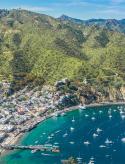Santa Catalina Island’s future as a vacation destination was first envisioned in the late 1880s by George Shatto, who owned the island at the time. The developer mapped out the streets of what he proposed calling Shatto -- but was luckily convinced by his sister-in-law to name Avalon.
Since then, the island’s subsequent owners have continued and expanded Shatto’s vision, transforming the island into a world-class travel destination. While it continues to be a travel hotspot, Catalina then was very different from Catalina now.
Travel to Catalina Island
Today, the ferries to Catalina Island ply the channel dozens of times a day, bringing visitors to Catalina throughout the year. In the sky, scheduled helicopter service whisks travelers to the island in just about 15 minutes.
The convenience and speed of boat travel to Catalina Island stands in stark contrast to yesteryear, when getting to Catalina took more than two hours. Those two hours were filled with dancing to big bands and culminated with a grand welcome to the island, complete with speedboats, water skiers and Island youth diving for coins. Over the last century, several steamships made the crossing, but the most famous was the Great White Steamer, officially known as the SS Catalina, which served as the primary means of transportation to Catalina Island from 1924 to 1975.
With the burgeoning popularity of helicopters, air travel to Catalina Island also changed dramatically. For decades, seaplanes made a splash, bringing hundreds of thousands of travelers to Avalon, landing just offshore and then motoring to Hamilton Cove, and later, Pebbly Beach.
Lodging on Catalina Island
Catalina Island is home to about 800 hotel rooms, ranging from family – and budget – friendly options to four-star luxury bed and breakfasts. Hundreds of Catalina vacation rentals provide another option for accommodations and camping is available at several campsites.
Speaking of camping, one of the first options for lodging on the island was a vast tent city, spread across Avalon’s streets. For generations, these tent cabins hosted families for week-long vacations on Catalina.
Tent cabins were far from the only lodging option. Early Catalina Island hotels included the Metropole, a stately waterfront icon that was lost in the great fire of 1915, and the St. Catherine Hotel, an expansive luxury waterfront property that graced Descanso Beach from 1918 to 1966.
What to wear on Catalina Island
Today, a packing list for Catalina Island needs to include a bathing suit, light jacket, hat, sunscreen and a collection of casual resort wear.
That’s a far cry from yesteryear, when, like most destinations, dress was much more formal. Strolling Avalon’s streets in the 1900s, visitors would have been dressed in hats and jackets for the men for the full-length dresses for women. Beachwear in particular has transformed – women in the 1900s wore woolen bathing costumes – complete with socks – when cavorting on Avalon’s beaches.
Catalina underwater
Catalina Island’s underwater world continues to intrigue visitors and residents alike. Whether staying dry in a semi-submersible or plunging beneath the surface on scuba adventure, Catalina’s crystal clear waters are a siren call to those interested in life under the sea. Consistently voted one of the top dive destinations in North America, the island also offers snorkeling, snuba and see-thru kayaks.
While modern-day undersea explorers have an array of ways to explore the marine world, early travelers had other options, including a submarine diving bell that operated at what is now the Casino Point Dive Park, an underwater theater in Lover’s Cove and a submersible that took explorers up to 30 feet beneath the surface near the Cabrillo Mole.
Underwater adventures have come and gone, but one activity has stood the test of time. Glass bottom boats were one of the first ways visitors got a glimpse beneath the surface. Intrepid anglers turned entrepreneurs replaced the bottom of rowboats with glass and charged fascinated travelers to journey out to see under the sea. Even though the vessels themselves have evolved, the popularity of glass bottom boats has never wavered and they continue their popularity today.
Catalina Island attractions and things to do
The island’s most iconic attraction continues to be the architectural masterpiece of the Casino Building. Opened in 1929 and containing a movie theatre and ballroom, the Casino is one of the most recognizable landmarks in the country and is a must-see attraction on Catalina.
Golfing on Catalina Island has been popular since before the turn of the last century. Originally constructed as a three-hole course, the Catalina Golf Course was expanded to 18 holes in 1929; but is now a nine-hole course with options for expanded play.
Visitors will discover relics of one of Avalon’s historic attractions in Avalon Canyon. The Avalon Bird Park fascinated visitors as one of the country’s largest collections of exotic birds for 35 years. Swans, parrots, ostriches, peacocks, pelicans and hawks were just a few of the feathered creatures on display. Closed in 1966, the Bird Park’s flight-house and entrance stand to this day, a testament to that long-ago Catalina attraction.
Modern-day bird lovers will discover a wide range of wild resident and migrating birds, including bald eagles, humming birds, wood peckers, Catalina Island quail and much more. A falconry program helps control the pigeon population and provides visitors a way to get up close and personal with the majestic birds.
Catalina Island in the future
As it has for more than a century, Catalina Island will continue to evolve as a vacation destination. New attractions, new hotels and new experiences are all on the horizon. One hundred years from now, looking back, Catalina will be as different then as it is now.


